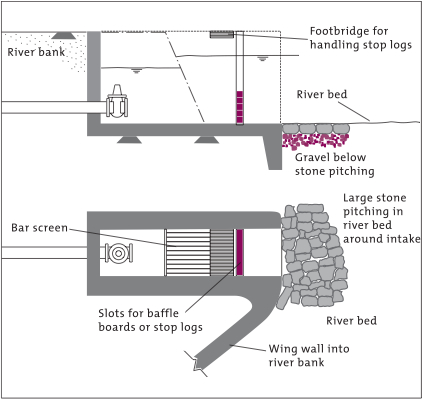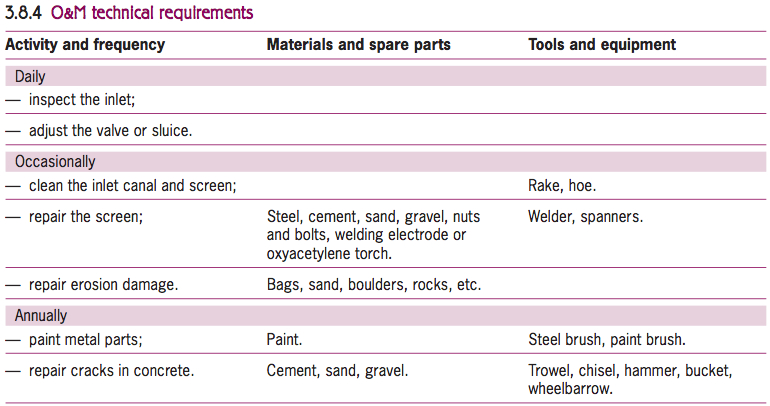Difference between revisions of "Water Portal / Rainwater Harvesting / Surface water / Protected side intake"
(→Construction, operations and maintenance) |
|||
| Line 4: | Line 4: | ||
==Construction, operations and maintenance== | ==Construction, operations and maintenance== | ||
| − | [[Image:protectedSideIntake.jpg|thumb|right|300px|Protected side intake diagram. Photo: WHO.]] | + | [[Image:protectedSideIntake.jpg|thumb|right|300px|Protected side intake diagram. Click to zoom. <br> Photo: WHO.]] |
— Operation of a protected side-intake system is usually carried out by a caretaker; <br> | — Operation of a protected side-intake system is usually carried out by a caretaker; <br> | ||
— a valve or a sluice may have to be adjusted daily, the inlet to the channel or pump checked for obstructing debris, and any damage repaired; <br> | — a valve or a sluice may have to be adjusted daily, the inlet to the channel or pump checked for obstructing debris, and any damage repaired; <br> | ||
Revision as of 06:06, 30 April 2012
A protected side intake provides a stable place in the bank of a river or lake, from where water can flow into a channel or enter the suction pipe of a pump. It is built to withstand damage by floods and to minimize problems caused by sediment. Side intakes are sturdy structures, usually made of reinforced concrete, and may have valves or sluices to flush any sediment that might settle. Often, a protected side intake is combined with a weir in the river to keep the water at the required level, a sand trap to let the sand settle, and a spillway to release excess water. The river water may enter the side intake through a screen, and a spillway overflow may be provided. Sometimes, protected side intakes are combined with a dam and a flushing sluice, which allows the upstream part of the river to be flushed.
Contents
Suitable conditions
Construction, operations and maintenance
— Operation of a protected side-intake system is usually carried out by a caretaker;
— a valve or a sluice may have to be adjusted daily, the inlet to the channel or pump checked for obstructing debris, and any damage repaired;
— preventive maintenance, including painting the screens and other metal parts, such as sluices or valves;
— the intake canal and silt trap may have to be de-silted, debris cleaned from the screens regularly, and damaged screens should be welded;
— during the rainy season, the inlet may need checking and cleaning more frequently;
— any erosion of the river bank or bed must be repaired immediately with boulders, rocks, sandbags, etc.;
— cracks in the concrete structure should be repaired every year;
— annual cleaning and major repairs (these may require the assistance of the water users);
— after flooding, cleaning may be necessary.
Potential problems
— clogging by silt or debris;
— the side-intake system may be undermined by river currents;
— the river or lake water may be polluted.
Costs
References, videos, and links
Acknowledgements
Costs
Field experiences
Reference manuals, videos, and links
Acknowledgements
- Brikke, François, and Bredero, Maarten. Linking technology choice with operation and maintenance in the context of community water supply and sanitation: A reference document for planners and project staff. World Health Organization and IRC Water and Sanitation Centre. Geneva, Switzerland 2003.


